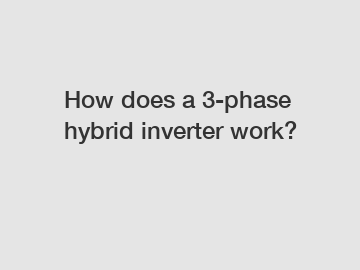How does a 3-phase hybrid inverter work?
In the quest for clean and sustainable energy, solar power has emerged as a frontrunner. To harness its full potential, an essential ingredient is an inverter – a device that converts direct current (DC) generated by solar panels into alternating current (AC) for everyday use. While single-phase inverters have traditionally been the go-to choice for residential solar installations, the increasing demand for more power-efficient systems has given rise to the 3-phase hybrid inverter. In this blog, we unravel the intricacies of this advanced technology, shedding light on how it works and why it is becoming increasingly popular.
I. The Anatomy of a 3-Phase Hybrid Inverter:
At its core, a 3-phase hybrid inverter is primarily designed to enable the integration and management of solar power with the electrical grid. Unlike single-phase inverters that operate with only one phase of the electrical system, a 3-phase hybrid inverter is engineered to manage energy across all three phases of a typical power distribution system, making it ideal for larger residential or commercial installations.

1. Solar Panel Connection:
Similar to single-phase inverters, a 3-phase hybrid inverter is connected directly to the solar panels, where it receives the DC electricity generated by converting sunlight. The inverter's MPPT (Maximum Power Point Tracking) algorithm optimizes the energy harvesting process, ensuring the solar panels operate at their peak efficiency, irrespective of varying sunlight conditions. A key advantage of a hybrid inverter is that it can efficiently handle uneven panel degradation across the entire system, resulting in maximized power output.
2. Battery Integration:
One of the distinguishing characteristics of a 3-phase hybrid inverter is its ability to integrate energy storage solutions, such as batteries. This feature allows users to harvest excess solar power during the day and store it for use during periods of high demand or at night when the solar panels are not producing electricity. The inverter controls the charge and discharge cycles of the batteries, ensuring optimal utilization while also extending their lifespan.
3. Grid Interaction:
Apart from managing solar power, a 3-phase hybrid inverter facilitates seamless interaction with the electrical grid. It can monitor the grid's voltage and frequency, adjusting its output to inject excess solar energy back into the grid. This process, known as grid-tie functionality, helps in offsetting energy consumption costs by potentially earning credits or reducing utility bills through net metering.
II. The Working Principle of a 3-Phase Hybrid Inverter:
1. Conversion of DC to AC:
Upon receiving the DC electricity from the solar panels, the 3-phase hybrid inverter utilizes advanced power electronics to convert it into AC electricity, suitable for powering electrical appliances. The inverter synchronizes the AC output with the grid voltage and frequency to ensure optimal compatibility.
2. Intelligent Power Flow Management:
A critical feature of a 3-phase hybrid inverter is its ability to intelligently manage power flow between the solar panels, batteries, and the electrical grid. Through sophisticated algorithms and advanced monitoring systems, the inverter dynamically determines the most efficient source of power at any given time, enabling seamless transitions between the solar and battery storage systems. This dynamic load management ensures maximum self-consumption of solar energy while minimizing reliance on the grid.
3. Real-Time Monitoring and Remote Control:
To empower users with valuable insights into their energy consumption and generation, 3-phase hybrid inverters come equipped with advanced monitoring and control systems. Users can access real-time data through intuitive interfaces or smartphone applications, allowing them to visualize their energy usage patterns, monitor battery status, and even remotely control the system's settings.
Conclusion:
As the demand for clean and sustainable energy grows, 3-phase hybrid inverters have emerged as an essential component in solar power installations. Bringing together advanced power electronics, battery integration capabilities, and seamless grid interaction, these inverters offer users enhanced efficiency, increased self-consumption, and significant cost savings. By understanding the inner workings of a 3-phase hybrid inverter, we can fully embrace the power of solar energy and contribute to a greener future.
The company is the world’s best durable single phase string inverter, ac coupled inverters, hybrid inverter supplier supplier. We are your one-stop shop for all needs. Our staff are highly-specialized and will help you find the product you need.
175
0
0

Comments
All Comments (0)